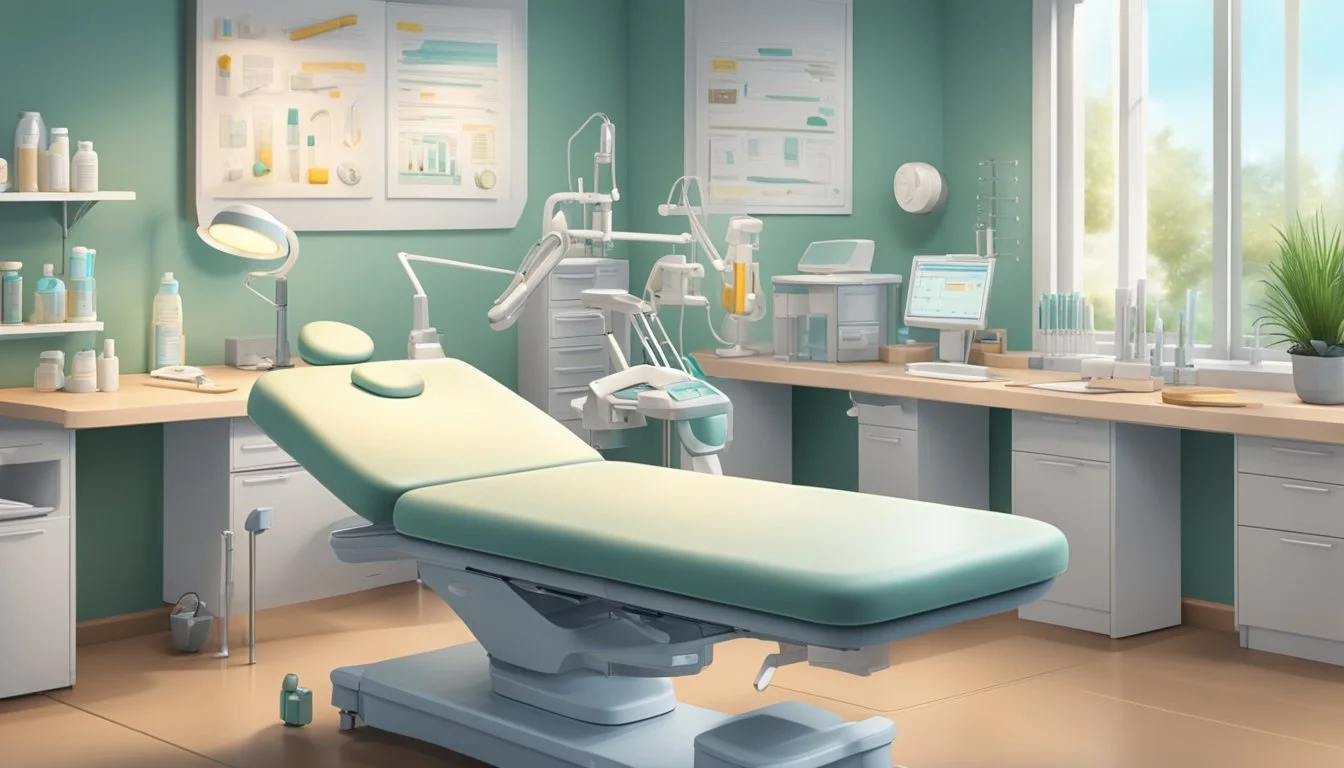5 Techniques for Managing PTSD-Related Vulvodynia
Effective Strategies for Relief
Vulvodynia, often characterized by chronic pain in the vulvar area, can severely impact a woman’s quality of life, especially when linked with PTSD. Persistent feelings of discomfort and pain during everyday activities can cause both physical and emotional distress.
Addressing this intersection between PTSD and vulvodynia requires specialized techniques tailored to manage both conditions simultaneously. Understanding these strategies is crucial for alleviating symptoms and improving overall well-being for affected individuals. The article will explore five effective techniques that offer practical solutions for managing PTSD-related vulvodynia.
1) Mindfulness-Based Stress Reduction
Mindfulness-Based Stress Reduction (MBSR) is an evidence-based modality first developed by Jon Kabat-Zinn. It has demonstrated effectiveness in alleviating a wide range of physical and mental health issues, including PTSD.
MBSR focuses on enhancing mindfulness through practices such as meditation, yoga, and body scans. These activities help individuals become more present and aware of their bodily sensations and thoughts.
For those experiencing PTSD-related vulvodynia, MBSR can reduce stress and anxiety by promoting a calmer state of mind. This reduction in stress can lead to decreased perception of pain.
Studies have shown that mindfulness-based treatments for PTSD, including MBSR, have low attrition rates and medium to large effect sizes. This makes MBSR a promising intervention for managing chronic pain and trauma symptoms.
Reading guides such as the Mindfulness-Based Stress Reduction Workbook by Dr. Bob Stahl and Dr. Elisha Goldstein can offer practical methods for integrating MBSR into daily life.
The consistent practice of MBSR can empower individuals to cope better with PTSD and associated vulvodynia, leading to improved quality of life.
2) Pelvic Floor Physical Therapy
Pelvic floor physical therapy can play a crucial role in managing PTSD-related vulvodynia. Vulvodynia often involves dysfunction or hyperactivity of the pelvic floor muscles. Pelvic floor therapists specialize in identifying and treating these muscle issues.
Therapists use a variety of techniques to address muscle hyperactivity, including manual therapy. This may involve internal or external manipulations to relax the muscles and provide pain relief.
In addition to manual therapy, pelvic floor therapy often includes targeted exercises. These exercises help improve muscle control and reduce muscle tone at rest. Patients may also receive education on posture and relaxation techniques.
Biofeedback is another tool frequently used in pelvic floor physical therapy. This method utilizes sensors to provide real-time feedback. It aids patients in learning how to control their pelvic floor muscles more effectively.
Pelvic floor therapy can also address myofascial trigger points. Trigger points are small, sensitive areas in the muscles that can contribute to pain. Therapists work to release these points, reducing discomfort and improving muscle function.
Evidence supports the effectiveness of pelvic floor physical therapy for vulvodynia. Studies have demonstrated significant improvements in pain levels, sexual function, and quality of life. For many, pelvic floor physical therapy offers a pathway to better manage vulvodynia's symptoms.
For further insight, refer to the clinician's guide on pelvic floor physical therapy.
3) Cognitive Behavioral Therapy (CBT)
Cognitive Behavioral Therapy (CBT) is a well-established approach for addressing PTSD and its associated symptoms. It focuses on the relationship between thoughts, feelings, and behaviors, aiming to modify unhelpful thought patterns.
CBT proceeds by identifying and challenging negative thought patterns that exacerbate PTSD symptoms. This restructuring helps the patient adopt healthier perspectives and reduce emotional distress.
A key technique in CBT is exposure therapy, where patients gradually confront trauma-related memories or triggers in a controlled manner. This reduces the power of those triggers over time.
CBT for PTSD often includes skill-building to improve coping mechanisms. Patients learn relaxation techniques and cognitive restructuring to manage stress and anxiety effectively.
The therapy is usually structured with 12-20 sessions, each lasting about 50 minutes. The goal is to provide tangible tools and strategies that the patient can use long-term.
For managing PTSD-driven conditions like vulvodynia, CBT can be particularly beneficial. It helps in breaking the cycle of pain and fear, reducing both psychological and physical symptoms.
By focusing on current problems and equipping patients with practical skills, CBT offers an effective treatment pathway for managing complex conditions. This can lead to significant improvements in overall functioning and quality of life.
4) Acupuncture and Traditional Chinese Medicine
Acupuncture, a key component of Traditional Chinese Medicine (TCM), is increasingly considered for managing PTSD-related vulvodynia. Acupuncture involves the insertion of fine needles into specific points on the body to balance the flow of energy, or qi. This practice is believed to alleviate various symptoms, including pain and stress.
Patients experiencing PTSD may benefit from acupuncture's calming effects. According to clinical studies, acupuncture has shown positive effects on PTSD symptoms, which can indirectly help with vulvodynia by reducing stress and anxiety levels.
Traditional Chinese Medicine also includes herbal treatments that complement acupuncture. Some case studies suggest that specific herbal formulas, such as the Gathering Qi formula, can improve overall well-being by addressing underlying imbalances.
Combining acupuncture with herbal treatments provides a holistic approach. This method not only targets the physical symptoms but also addresses the emotional and psychological aspects of PTSD. This dual approach can be particularly useful for those whose vulvodynia is closely linked to trauma-related stress.
In summary, acupuncture and Traditional Chinese Medicine offer promising complementary therapies for managing PTSD-related vulvodynia by addressing both emotional and physical symptoms.
5) Gabapentin Medication
Gabapentin is an oral medication that has shown promise in treating vulvodynia, particularly in patients with PTSD-related symptoms.
It works by stabilizing abnormal electrical activity in the brain and altering the way the body senses pain.
Studies have indicated that dosages ranging from 1200 to 3000 mg/day can help reduce pain intensity in patients experiencing vulvodynia.
In a randomized controlled trial, gabapentin was found to significantly reduce pain during a standardized tampon test, used as a marker for dyspareunia.
The medication has also been mentioned in the 2021 European guidelines for managing vulvodynia, alongside other treatments like 5% lidocaine ointment and oral amitriptyline.
Gabapentin's exact mechanism in treating vulvodynia is not fully understood, but its efficacy has been supported by several studies and clinical evidence.
It is important to consult with a healthcare provider to determine the appropriate dosage and monitor for potential side effects. Patients may experience relief from their symptoms, enhancing their quality of life.
Gabapentin is part of a multifaceted approach, which may include other medications, physical therapy, and lifestyle changes.
It's one of several options available, and its use should be tailored to individual patient needs, always under medical supervision.
Understanding PTSD-Related Vulvodynia
PTSD-related vulvodynia is a complex condition with various symptoms and unique diagnostic challenges. Understanding this condition involves looking at its definition, how it manifests, and the connection between PTSD and vulvodynia.
Definition and Overview
PTSD-related vulvodynia involves chronic vulvar pain without an identifiable cause, often linked to trauma. This pain can persist for months or years, severely affecting quality of life.
Vulvodynia is characterized by burning, stinging, irritation, or rawness in the vulvar area. It can be localized or generalized, and may fluctuate in intensity. Unlike typical pain conditions, vulvodynia lacks a visible cause, making diagnosis and treatment a challenge.
Symptoms and Diagnosis
The symptoms of PTSD-related vulvodynia are primarily pain, which can be spontaneous or provoked by touch, intercourse, or even sitting. Additional symptoms might include swelling, redness, or a feeling of rawness.
Diagnosis typically requires a detailed medical and psychological history, pelvic examination, and exclusion of other conditions. Healthcare providers may use a cotton swab test to pinpoint painful areas. Proper diagnosis is crucial for effective management and treatment.
Link Between PTSD and Vulvodynia
The link between PTSD and vulvodynia is evident in the increased prevalence of vulvodynia among women with PTSD. Studies indicate that women with PTSD are significantly more likely to suffer from vulvodynia.
This association suggests a potential interplay between emotional trauma and chronic pain. PTSD may contribute to vulvodynia through mechanisms such as heightened pain sensitivity and pelvic floor dysfunction. Understanding this connection is essential for developing effective treatment strategies that address both physical and psychological aspects of the condition.
Medical Treatments
Approaches to managing PTSD-related vulvodynia often include pharmacological options, physical therapy interventions, and, in some cases, surgical procedures. Each method aims to alleviate pain and improve the quality of life for those affected.
Pharmacological Options
Medications play a crucial role in managing vulvodynia symptoms. Tricyclic antidepressants such as amitriptyline and desipramine are frequently prescribed to reduce chronic pain. Anticonvulsants like gabapentin and pregabalin are also effective in neuropathic pain management.
Topical treatments, including lidocaine gels, provide localized pain relief. Hormone creams may be used to address hormonal imbalances that exacerbate symptoms. Injections of corticosteroids or botulinum toxin offer another option, targeting specific areas to reduce inflammation and pain.
Physical Therapy Interventions
Physical therapy includes several techniques aimed at alleviating pelvic floor muscle tension, which is often associated with vulvodynia. Pelvic floor therapy involves exercises designed to strengthen and relax pelvic muscles. Biofeedback helps individuals gain better control over these muscles, potentially reducing pain.
Manual therapy, or hands-on manipulation of the pelvic area, can also provide relief. Techniques such as myofascial release and trigger point massage target specific pain points. Physical therapists may also teach patients targeted stretches and exercises to incorporate into their daily routines.
Surgical Options
Surgical interventions are considered a last resort for vulvodynia. Vestibulectomy, the removal of painful tissue around the vaginal opening, can be effective for localized pain. This procedure is usually recommended when other treatments fail to provide relief.
Another surgical option is nerve ablation, which involves disrupting the nerves responsible for transmitting pain signals. While these procedures can offer significant relief, they come with risks and potential complications. Therefore, a thorough evaluation and consultation with a specialist are essential before proceeding with surgery.
By exploring these medical treatments, patients with PTSD-related vulvodynia can find effective strategies for managing their symptoms and improving their overall well-being.
Psychological Approaches
Managing PTSD-related vulvodynia requires comprehensive psychological strategies. These approaches aim to alleviate emotional and mental distress that exacerbates physical symptoms, enhancing overall well-being.
Cognitive Behavioral Therapy
Cognitive Behavioral Therapy (CBT) focuses on identifying and altering negative thought patterns and behaviors. It helps patients challenge and change distorted cognitions related to their pain and trauma.
For individuals with PTSD-related vulvodynia, CBT can reduce pain perception and improve coping mechanisms. Techniques such as cognitive restructuring enable patients to reframe distressing thoughts. Behavioral activation encourages engaging in enjoyable activities, countering avoidance behaviors typical in PTSD.
CBT sessions are often structured and goal-oriented, providing practical tools over a series of sessions. Therapists guide patients to develop resilience and healthier thought patterns, promoting long-term mental health.
Mindfulness and Relaxation Techniques
Mindfulness and Relaxation Techniques are effective at managing chronic pain and associated stress. These methods include mindfulness meditation, progressive muscle relaxation, and deep breathing exercises.
Mindfulness meditation encourages patients to focus on the present moment, reducing anxiety and stress. It can help those with vulvodynia by decreasing their focus on pain. Progressive muscle relaxation involves tensing and relaxing different muscle groups, which can ease physical tension caused by stress and anxiety.
Practicing these techniques regularly can create a state of relaxation and decrease overall stress levels. Integrating mindfulness into daily routines can offer sustained relief from chronic pain and PTSD symptoms.
Support Groups and Counseling
Support Groups and Counseling provide essential emotional support and shared experiences for those with vulvodynia. Group settings allow individuals to connect with others facing similar challenges, reducing feelings of isolation.
Counseling, whether individual or group, offers a safe space to express emotions and receive feedback. Therapists can help patients work through trauma, develop coping strategies, and improve interpersonal relationships.
Support groups often focus on education, sharing practical information about pain management. Both peer and professional support play a critical role in the psychological well-being of those dealing with PTSD-related vulvodynia. Regular participation can enhance emotional resilience and provide community support.






